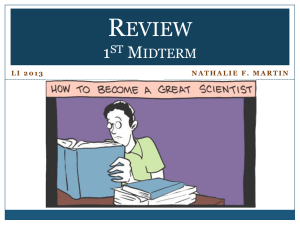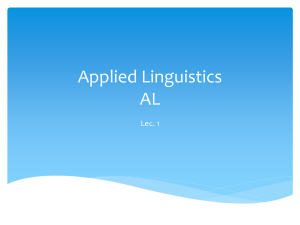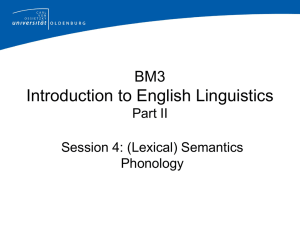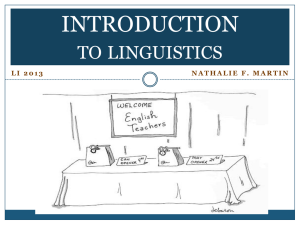Introduction to Linguistics
advertisement
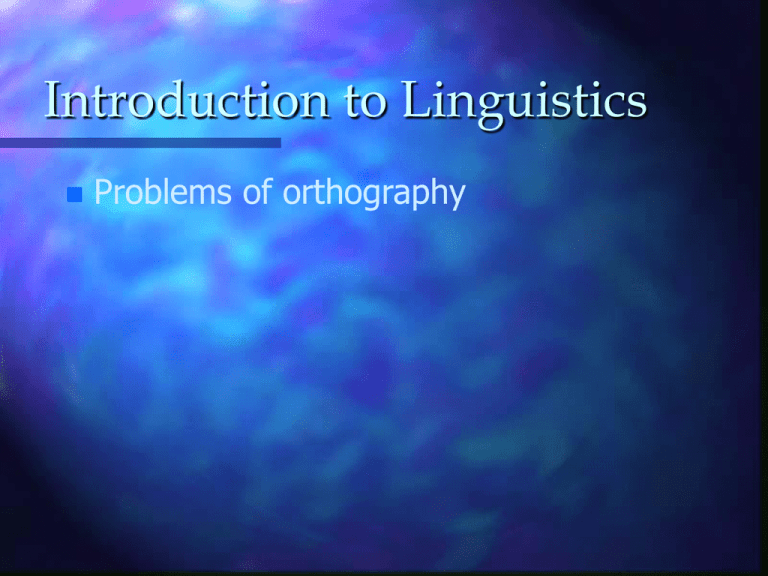
Introduction to Linguistics Problems of orthography Introduction to Linguistics Problems of orthography In English, as in the case of many other languages, one sound can be represented by more than one symbol (letter); likewise, one symbol can represent more than one sound. Introduction to Linguistics Problems of orthography In English, as in the case of many other languages, one sound can be represented by more than one symbol (letter); likewise, one symbol can represent more than one sound. /k/ in kick Introduction to Linguistics Problems of orthography In English, as in the case of many other languages, one sound can be represented by more than one symbol (letter); likewise, one symbol can represent more than one sound. /k/ in kick “ough” in bought, through, tough Introduction to Linguistics Problems of orthography To overcome the problems presented by orthography, linguists have developed phonemic and phonetic transcription systems. Introduction to Linguistics Problems of orthography To overcome the problems presented by orthography, linguists have developed phonemic and phonetic transcription systems. However, it’s important to remember that these transcription systems are still idealized ways of describing sounds, and are still abstract. Introduction to Linguistics Consonants of American English Introduction to Linguistics Consonants of American English How is a consonant defined? Introduction to Linguistics Consonants of American English How is a consonant defined? – – – 1) voiced or voiceless 2) place of articulation 3) manner of articulation Introduction to Linguistics Consonants of American English How is a consonant defined? – – – 1) voiced or voiceless Ex. /z/ and /s/, voiced and voiceless; /s/ is produced when vocal chords are tenser and further apart, thus causing less vibration. 2) place of articulation 3) manner of articulation Introduction to Linguistics Consonants of American English How is a consonant defined? – – – 1) voiced or voiceless 2) place of articulation Refers to where the sound is articulated: bilabial, labiodental, interdental, alveolar, alveopalatal, velar, glottal 3) manner of articulation Introduction to Linguistics Consonants of American English How is a consonant defined? – – – 1) voiced or voiceless 2) place of articulation 3) manner of articulation Describes how the sound is articulated: stops; fricatives, affricates, nasals, liquids and glides. Introduction to Linguistics Stops Introduction to Linguistics Stops are produced when the airflow is completely obstructed during speech. Introduction to Linguistics Stops are produced when the airflow is completely obstructed during speech. /p/ voiceless bilabial stop /b/ voiced bilabial stop /t/ voiceless alveolar stop /d/ voiced alveolar stop /k/ voiceless velar stop /g/ voiced velar stop Introduction to Linguistics Fricatives Introduction to Linguistics Fricatives are produced when the airflow is forced through a narrow opening in the vocal tract so that noise produced by friction is created. Introduction to Linguistics /f/ voiceless labiodental fricative /v/ voiced labiodental fricative /ø/ voiceless interdental fricative (as in think) /ð/ voiced interdental fricative (as in this) /s/ voiceless alveolar fricative /z/ voiced alveolar fricative Introduction to Linguistics // voiceless alveopalatal fricative (as in ship) // voiced alveopalatal fricative (as in measure) /h/ “glottal” fricative Introduction to Linguistics Affricates start life out as a stop, but releases into a fricative Introduction to Linguistics Affricates start life out as a stop, but releases into a fricative. – // voiceless alveopalatal affricate (as in chip) – // voiced alveopalatal affricate (as in judge) Introduction to Linguistics Nasals Introduction to Linguistics Nasals – In English, nasals are voiced oral stops, similar to other stops, with the exception that airflow and energy are channeled through the nasal passage Introduction to Linguistics Nasals – In English, nasals are voiced oral stops, similar to other stops, with the exception that airflow and energy are channeled through the nasal passage. /m/ bilabial nasal /n/ alveolar nasal // a velar nasal Introduction to Linguistics Liquids Introduction to Linguistics Liquids share aspects with both vowels and consonants, refers to their quality of flowing easily or smoothly. Introduction to Linguistics Liquids share aspects with both vowels and consonants, refers to their quality of flowing easily or smoothly. In English, both examples are voiced. /l/ lateral alveolar liquid /r/ nonlateral alveolar liquid Introduction to Linguistics Glides Introduction to Linguistics Glides – Glides are vowel-like articulations that precede and follow true vowels, sometimes called “semi-vowels” Introduction to Linguistics Glides – Glides are vowel-like articulations that precede and follow true vowels, sometimes called “semi-vowels” /y/ alveopalatal glide /w/ labialized velar glide /hw/ labialized velar glide with a voiceless beginning), as in which. Introduction to Linguistics Vowels of American English Introduction to Linguistics Vowels of American English How is a vowel defined? Introduction to Linguistics Vowels of American English How is a vowel defined? – – As a relatively open sound Formed by the different shapes of the open, resonating vocal tract and the variety of shapes determined by the position of several anatomical structures. Introduction to Linguistics Vowels of American English What flavors do they come in? Introduction to Linguistics Vowels of American English What flavors do they come in? – – – – Lax (or short) Tense (or long) Reduced Described variously as: high/mid/low and front/back relative to position of the part of the tongue closest to the roof of the mouth Introduction to Linguistics Lax: /I/ lax high front, ex bit, wish /e/ lax mid front, ex get, mess /æ/ lax low front, ex ash /U/ lax high back, ex put, foot / / lax mid back, ex putt, luck /Y/ lax low back, ex hot, pot /]/ lax low back rounded, ex caught Introduction to Linguistics Tense – /iy/ tense high front (with /y/ offglide), ex bead, three – /ey/ tense mid front (with /y/ offglide), ex clay, weigh – /uw/ tense high back (rounded with /w/ offglide) ex. shoe, crude – /ow/ tense mid back (rounded with /w/ , ex boat, tow – /oy/ tense mid back (rounded with /y/ offglide), ex boy – /aw/ tense low back (with /w/ offglide), ex cow, blouse – /ay/ tense low back (with /y/ offglide), ex my, thigh – /a/ tense low - East Coast Variant, “Park the car in Harvard yard.” Introduction to Linguistics Reduced (always unstressed) Schwa (mid back) /c/ - sofa Barred-i (high back) /v / - chiken Introduction to Linguistics The distinct sounds of a language are called phonemes (a minimal unit of sound) Introduction to Linguistics The distinct sounds of a language are called phonemes (a minimal unit of sound) English has 39 phonemes (24 con’nts, 15 vowels) Introduction to Linguistics The distinct sounds of a language are called phonemes (a minimal unit of sound) English has 39 phonemes (24 con’nts, 15 vowels) Hawaiian has 13 (8/5); Georgian has 90 (70/20) Introduction to Linguistics Vowels tend to have little variation, consonants a great deal. – Xhosa and the click phoneme

